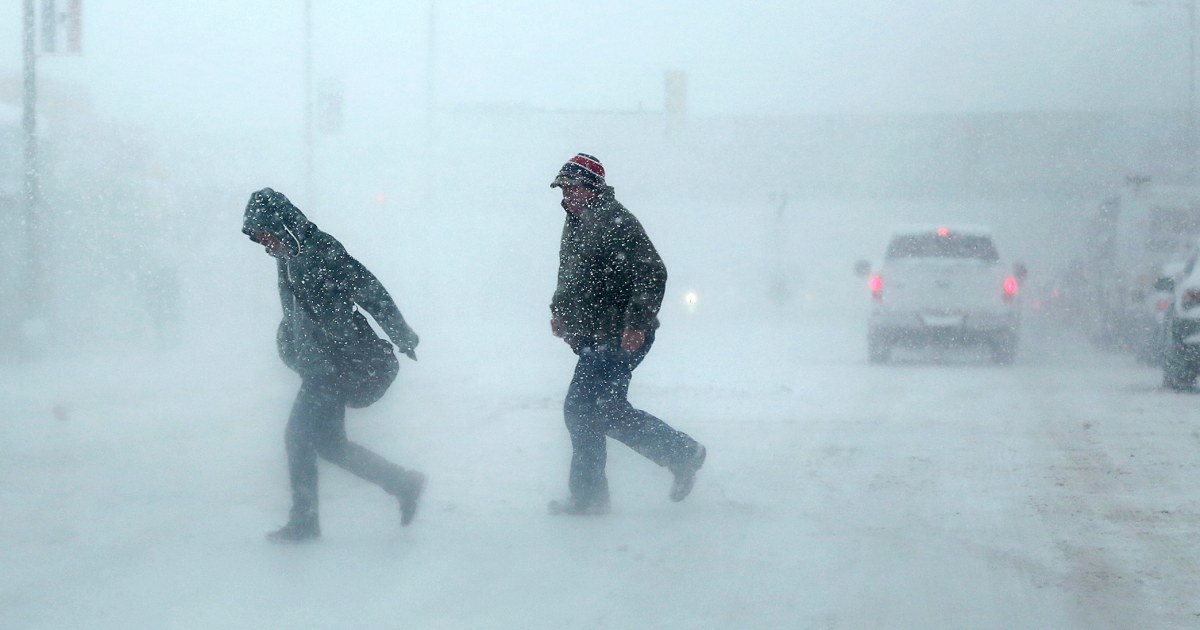About 42 million people are under winter alerts from California to Maine, with Minneapolis bracing for its biggest snowstorm in more than a decade and life-threatening travel conditions.
Blizzard warnings have been issued for parts of the Rocky Mountains, the Northern Plains, and the Upper Midwest. St. Cloud, Minnesota, was already below one.
The extreme weather was the result of multiple winter fronts that moved from west to east and brought cold air from the north, federal forecasters said.
Forecasters warned that Minneapolis could be added to blizzard warnings later Tuesday, which would be rare for the historically snowy city.
Up to 1 foot of snow has already fallen in northern Minnesota, according to the National Weather Service.
«Due to the obstructions, it’s hard to get blizzard conditions in major metropolitan areas like the Twin Cities, but with actively falling snow and high winds, this would be an event that could do it,» the National Weather Service in the Twin Cities said. . he said in his Tuesday morning forecast.
The storm will deliver two rounds of snow totaling 1 to 2 feet by the time the system ends Thursday.
snow timeline
The first round of snow began around lunchtime Tuesday across the region, with 5 to 7 inches (locally higher 8 to 9 inches) possible overnight. Winds are expected to be in the 10-15 mph range.
A break is expected on Wednesday from 6 am to noon local time. Light snow could be falling, but some spots along Interstate 90 could see a complete break.
The second round is expected to begin around noon Thursday, adding 10 to 15 inches to the snowfall total and producing wind gusts of 45 to 50 mph on occasion.
By the time the round is over, a large area of southern Minnesota will have more than a foot of snow, with some areas accumulating almost 2 feet.
Rapid City is forecast to get 8 to 14 inches and Marquette could see 12 to 18 inches.
If the current forecast of 18 to 25 inches of snow holds for Minneapolis, it will be the city’s biggest snowstorm in 12 years, according to the Minnesota Department of Natural Resourcesand has the potential to be one of the five largest in the city.
Travel will be affected
Heavy snow falling at a rate of 1 to 2 inches per hour combined with high wind gusts will make travel impossible and life-threatening for 12 or more hours Wednesday night through Thursday in the Twin Cities and their surrounding areas. surroundings.
Cities most likely to experience treacherous travel conditions, power outages, downed trees, and blackout conditions due to ice sheet include Chicago, Detroit, Hartford, Connecticut; DesMoines, Iowa; Madison, Wisconsin; Grand Rapids, Michigan; and Buffalo and Albany in New York.
Up to 8 million people are at risk from severe storms Wednesday that stretch from northern Missouri to the Oklahoma-Texas border. All hazards will be possible, including hail, high winds, and a tornado or two. Oklahoma City and Tulsa will be the cities most at risk for damaging winds from very fast storms.
Some precipitation was already moving through parts of the South into Ohio and Pennsylvania on Tuesday, with up to a half-inch of rain and snow reported, according to weather service data.
snow in california
The first of three additional fronts was moving into California with the promise of snow across the southern part of the state, including high desert communities and some valleys, reaching elevations as high as 1,500 feet, forecasters said.
National Weather Service Senior Meteorologist Alex Tardy said in a video presentation Southern California snowfall could be historic.
The front on Thursday was expected to produce an «atmospheric river» of precipitation from the tropical Pacific. Atmospheric rivers are known for their relatively moderate temperatures, but the front will bring heavy precipitation and cold temperatures, forecasters said.
Sustained winds along the coast of up to 50 mph were forecast for later in the week. Tardy said it was a 10-year event.
«It’s pretty remarkable to see something like this in Southern California,» Tardy said.
A winter storm watch was issued Tuesday for parts of the San Francisco Bay Area. The last time this happened was in 2011.
Up to 3 inches of snow is likely in the Santa Cruz Mountains and foothills of eastern Santa Clara County Wednesday night. This area will likely receive another watch on Thursday when an even colder storm rolls in.
Any snow accumulation will be highly unlikely in major cities like San Francisco and Los Angeles, but will likely fall nearby in the lower elevation mountains.
The first storm for the West Coast this week was making its mark on Tuesday. More than 124,000 utility customers lost power in the state, according to network tracker PowerOutage.us.
In the Bay Area on Tuesday, a downed tree blocked three lanes of westbound traffic on the Bay Bridge, NBC Bay Areaciting the California Highway Patrol, he reported.
Meanwhile, temperatures could rise 20 to 30 degrees above average in other parts of the country, leading to nearly 100 daily records.
If Washington, DC, hits 80 degrees on Thursday, it will be only the fourth time it has done so during a winter month. Orlando, Florida, could hit 90.

